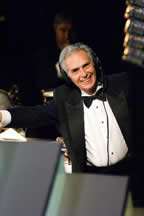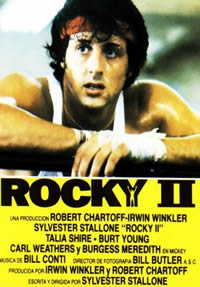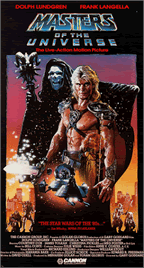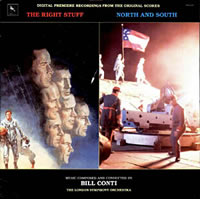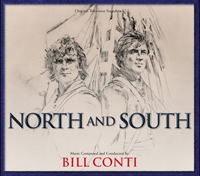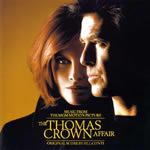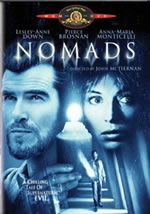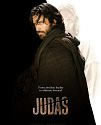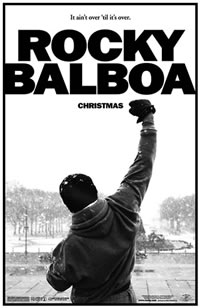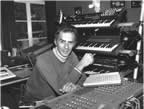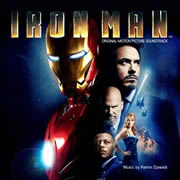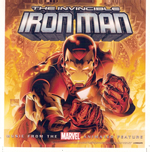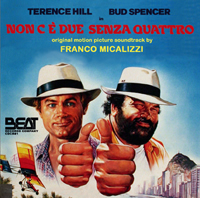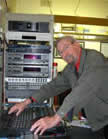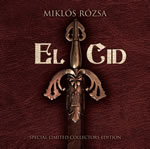 |
Soundtrax: Episode 2008-9
May 8, 2008
By Randall D. Larson
Bill Conti Full Circle with Bill Conti
This week we share a conversation with Bill Conti, who first made a hit out of his score for the triumphant underdog boxing film, Rocky, more than 30 years ago. We’ll take a walk across his filmography and gleaning some insights into his experiences scoring The Right Stuff, North & South, Masters of the Universe, Nomads, The Thomas Crown Affair, Judas, and coming full circle to Rocky Balboa and his most recent score, another triumphant underdog drama, The Perfect Game. Reviews this week include the long-awaited “Roar” Overture from Cloverfield by Michael Giacchino, Ramin Dwadai’s iron-clad score for the brand new Marvel super hero epic, Iron Man, the animated Invincible Iron Man score by champion animated super hero composer Guy Michelmore, Marc Streitenfeld’s music for Ridley Scott’s American Gangster, Conde’s The Abandoned from MovieScore Media, Micalizzi’s Brazilian comedy, Double Trouble(Non C’e’ Due Senza Quattro) from Beat, The Warlords,massive music for a massive new Jet Li epic historical action film from Hong Kong, and Joel Goldsmith’s spooky/scary music from TV’s Witchblade, on CD for the first time. Plus news of new and forthcoming scores, soundtracks, and film music books - including Lalo Schifrin’s autobiography.
Interview: A Conversation with Bill Conti
For many years Bill Conti has maintained a reputation as a composer for films about the heroic underdog, largely in response to his music for the popular Rocky films (he scored all but Rocky IV… so far) as well as the Karate Kid movies. Conti’s success in film music came about due to his association with Rocky in 1976, whose powerful and heroic hook captivated listeners and gave the film a lot of its emotive power. Ditto for Karate Kid, TV’s American Gladiators, and any number of other films in which Conti’s eloquent music accompanied the triumph of an unlikely underdog. But like with any other composer working in the pigeon-hole-friendly Hollywood environment, there’s a lot more to Bill Conti than that. His sensitive, passionate score for Murderers Among Us: The Simon Wiesenthal Story, and his energetic action scores for Prayer for the Dying, Gloria, Blood In Blood Out and others give powerful evidence that Conti is about a lot more than the cheer-inducing boxing montage, as splendid a musical montage as that was. Epic scores for the TV miniseries North and South and Philip Kaufman’s enthralling story of the birth of the American space program, The Right Stuff, the massive IMAX film Yellowstone, as well as a lavish heroic score for the 1987 live action version of Masters of the Universe (soon to be reissued on CD by La-La Land) gave Conti the opportunity to show his own “right stuff” at the forefront of a large symphony orchestra, while his treatment for James Bond in For Your Eyes Only and that of Thomas Crown in the 1999 Pierce Brosnan remake of The Thomas Crown Affair gave him their own dynamic challenges. I recently spoke with Bill Conti and took a walk through his filmography which, despite its diversity, still can’t help but come full circle: his return to the ring with 2006’s Rocky Balboa and now his latest score, another feel-good underdog triumphant film, The Perfect Game are sure to resonate with fans and moviegoers alike. The North and the South of Bill Conti – his past and his present future, dappled as it is with an impressive variety of diversity, nonetheless rests comfortably on his ability to continue to support the underdog and cheer him on to victory.
Q: Masters of the Universe was a large scale fantasy film of the type you hadn’t done before. What were your initial impressions of when you first came onboard that project?
Bill Conti: Those kinds of are things cartoons and the strenuous thing about them is that they take a lot of music. There’s no dead air. Because it’s fantasy, you see. Music, being the ultimate fantasy – music being non-literal, and in fact beyond non-literal: it’s anti-intellectual – you don’t think about the music. You have a reaction to music. You either like it or you don’t like it. You don’t think about “do I like this?” So when you deal with any fantasy, it assumes that there’s going to be lots of music, as opposed to reality. That might be obvious, but for a film composer that just means there’s going to be thousands of little bitty notes that I have to spend time composing, and everything is super-dramatic. I approached it in the Wagnerian way – meaning Valhalla opens up and there are the gods, there is the this, and this god tweaks this other god’s toes and then they’re off to the races. Wagner did all that with leitmotifs – every little character had a musical figure and he appears on the scene and he’s got a theme, so you begin with a catalog of character’s names/character’s themes, and then you can get from those little snippets to general storylines. In other words, if there’s a conquest, if there’s a goal to be met – and there’s always a goal to be met and always a conquest – and if there’s a bad guy and various reasons why you’re going to be prevented from that goal, all that stuff can have thematic implications. There’s a classic sense of what those things should be, but it’s difficult in a way, because realism is easy – she gets up, she walks across, she shoots him with a gun, he falls dead. See Spot Run. Now the thing about like non-humans and all of that stuff, you’ve got to keep the energy going and it’s just incessant.
Q: You worked with a number of orchestrators on Masters of the Universe? Was that due to the time constraints on the project?
Bill Conti: You always have orchestrators. That’s a tradition of Hollywood. If I were to do the score and the orchestration it would take X amount to do. The music may go from a piano sketch, which is like two lines of music, to staves, to six lines of music (six staves). Beyond six staves you are actually bringing it up to the full score, which is an orchestration. In other words, you come up with the themes, and now you dig in [and flesh it out]. Say you have the first dramatic moment that requires music – she picks up the gun, it goes boom, she walks across the room. So you’ve got to be in the right place at the right time, musically. You have to figure all that out and write music that fits. And while you’re doing that you’re thinking in your head, “there’s flutes, the woodwinds do this, the celli come up and do that,” and you write this on your sketch, be in two lines or six lines. Everything that you need to know about that musical theme, in terms of orchestration, is supposedly what the composer does. He creates the music for that moment. Now, let’s say you’ve got 90 minutes of music to do, so you go through the entire movie like that. That could take you – in the old days, a studio contract was ten weeks to do a movie. At some point in the history of film music, the ten week contract was the norm. There are exceptions, of course, but there was norm at one point. Ten weeks. You were on a picture three months. Now if you wrote two to three minutes a day, you thought you were doing pretty good. So when you add that up, you go through the entire score, it’s going to take you weeks to actually create the music. And you’ve accounted for the flute, the clarinet, but how do we get it to the orchestra? How does that individual flute player get to play his notes, because he only gets the parts that have his notes on them. Every instrument in the orchestra has a stave on the score. But the composer’s sketch may just say “clarinets” on one line, but on the score you have the three staves for the clarinets, two for the flutes, and so on. You have a score that might have 40 staves. Now someone’s got to fill in everything that you’ve said. It’s very tedious– not that it isn’t creative, because the person giving the orchestrator the two-line sketch is giving more leeway than the person who gives him a six-line sketch.
So orchestrators have been around from the beginning and what they actually do is prepare the score for the copyist to extract the parts for each one of the players. You’ve got a hundred people showing up, and in a case like Masters it had to be 85 to 95 players, a huge orchestra, and everybody gets a part. Now, that’s because it was copied, not from your sketch, from the score. Who did that? The orchestrator did that. So when you have 90 minutes of music and if you don’t have a ten week contract, but you have, say, six weeks, it would be a miracle to actually create the music let alone be the same guy to take it into the orchestrating phase. You could even take it into the copying phase, if you were the composer – you could do it all, but there are limits to the amount of time you’re given, so you have copyists, you have orchestrators.
Q: Masters of the Universe came out in the wake of the third Stars Wars movie, which series has become an icon of science-fantasy film music that is constantly being referenced one way or another by subsequent genre films. Were you asked at all to follow that influence, or that type of music, in your score for Masters?
Bill Conti: I think that that is a given. I can’t tell you how many movies I’ve done where one is asked to come from the depths and go the distance, if they don’t ask for the Rocky reference. I’ve give you another example, I want to do it in a respectful way, but it may not sound that way. 2001 was a cartoon, and Kubrick did not have the courage to use living composers – although Ligeti may have been alive at the time [yes, he died in 2006. –rdl] – but using something as pure as The Blue Danube was a way of depicting outer space, at least to Kubrick and his audiences – or using Ligeti for spooky/scary. Contemporary composers of the 20th Century never knew that what they were doing was going to become the cartoons for spooky/scary! What Pendereski, Ligeti, and all of the composers of the new century had been propagating, went immediately into film music as spooky/scary! So when John Williams does Star Wars, an enormous hit, he is just giving you a model for anything that follows, and Masters Of The Universe certainly follows that.
Q: One of your scores that I’m really fond of is The Right Stuff, which is a wonderful movie and a wonderful score. Coming into that film, what were your impressions, musically?
Bill Conti: The Right Stuff had a composer on before me [John Barry].* He was released and then I was brought in. I was at odds with Philip Kaufman, the director, who felt that it was a personal story of men’s lives and I kept saying, “but what about the rocket ships circling the earth and the entire space program?” I couldn’t get that out of my head, and we did disagree. He was making a film of personal stories of men, and I saw the American Space Program. And I went in that direction. How it ended up staying in the movie is beyond me, but it did!
Q: I’m so thankful that it did, because your score elevates the human drama, without diminishing it at all, and makes these guys into true adventurers and American heroes.
Bill Conti: I felt that. I don’t know that Philip felt that. He didn’t want that kind of a score, so it was kind of against all odds. I think the first composer was his choice, and it didn’t seem to work, and I don’t know who or how, I never heard it. Something didn’t work. So I was brought in and I just kind of did what I felt, and I felt it was the history of the American Space Program, which, boy, I thought it was a big deal.
Q: I’m pleased you recorded part of the score for that Varese album. Do you think there will ever be an actual true soundtrack of the whole score?
Bill Conti: I think that there will be. Bob Townsend has asked me if I had the tapes. I did prepare an album for The Right Stuff at the time, so I had a master copy, and then when the film did not do well, they cancelled the album. So there might yet be an original soundtrack.
Q: Along the same lines, North And South was another epic-scaled, massive score, which did just come out on a multi-disc set, again from Varese. Now this was an epic Western story covering the whole of the Civil War. What was your approach to scoring all of that?
Bill Conti: That was David Wolper. It was 24 hours of television, 12 hours in the Fall, and 12 hours in the Spring. He said, “I want Gone With The Wind.” So to me that meant, again, you have to come up with a big theme. Something that really evoked a sweeping [scope], in other words, Gone With The Wind has a feel to it, so I did it in my own way. I certainly didn’t imitate Gone With The Wind in any way, except that I think it feels as big, it feels as sweeping, and David liked it, which was the most important part because if he didn’t, it wouldn’t have been there! And then everything else after that becomes a love story. In other words, you’ve got the setting, you know where you are, this is the Civil War, John Jakes, the North and the South, but what is it really about? Well, guy falls in love with this girl, he falls in love with the other one, it’s a setting for Once Upon A Time and then you tell a story, so then the music becomes the same old thing – she loves him, he loves her, scare me, go get ‘em, it’s either helicopters or guys from the South against the guys from the North. The music doesn’t care: it’s just pursuing an emotion. And it was one of those blood-bathy moments of it all had to be done very quickly, so I would write every day up until 6 o’clock at night, and then eat and at 7 o’clock till midnight I would record at Burbank, and then come back home and just continue writing for twelve hours, and then go back and record. And I think in two or three weeks the first 12 hours was over. It’s a good thing I was young! Painful!
Q: I wanted to ask you about the remake of The Thomas Crown Affair. Coming into that film, obviously it’s a remake but clearly you’re brought in to do something new and not simply replicate Michel Legrand…
Bill Conti: John McTiernan directed The Thomas Crown Affair. My connection with John McTiernan was from a movie called Nomads [1986], which he directed and Pierce Brosnan starred in. It was scary type picture, but it probably didn’t go anywhere. So I knew John, and I told him when I came in to do Thomas Crown Affair, that I was actually a little afraid of it because the Michel Legrand score is great.
Q: Another iconic type of a score.
Bill Conti: A wonderful score. And the movie was a classic. So I said, “John, are you afraid? Because I’m afraid!” He said, “No, we’re just telling a story. We’ve got the same characters, but we’re just telling a story. You just do you, I’ll just do me.” And it was true. I was a little but more intimidated but he just took the curse off. “Come on – we’ll never change the original. We’re not trying to be better than or as good as the original; we’re just going to tell a story and do it our way.” Which is true, and if someone says “oh, I like this one better” well, of course!
Q: The thing that struck me about Thomas Crown Affair is that it’s a very playful score. Just as the story is teasing the audience with what’s really happening, the score does that too, especially in the museum scene with all the top hats.
Bill Conti: For that scene I thought of something that was interesting. Besides the four pianos that were banging away, I used a tap dancer. I brought in a professional tap dancer and I gave him the music, and he’s like a percussionist, like some people use a typewriter, like just last year in Atonement. Well, Thomas Crown Affair had a tap dancer. No one should [notice], but those little tappy things that are happening are a tap dancer.
Q: You mentioned Nomads. That film, along with the episode of Tales From the Crypt that you wrote, this was your only real excursion into horror film music. It’s about a guy who is followed by evil spirits…
Bill Conti: I did that score all synthetically with Ted Nugent on guitar.
Q: What was approach to evoking the kind of spooky/scary needed by this film? What did a horror film need, musically, in 1986?
Bill Conti: Sometimes the most chilling things are achieved with less. In other words, if you’re supposed to jump out of your chair, sometimes the unexpected shot, the dead body, the people jumping out of the closet, whatever it is, that’s like a device that is heavy handed, and the director can use it at any time he wants. It’s accompanied by music and usually loud. The other kind or approach is internalizing something that you’re imagining – it’s actually not happening in front of you eyes, but you’re imagination is taking you there. The scene can look very benign, but the music can be getting a little spooky, and the play between the obvious and the misdirection – misdirection works in comedy as it does in horror, where you think this is going to happen and then something else happens. Except for the 20th Century music that has become a part of the nomenclature, before that we only had Psycho and Bernard Herrmann’s shrieking violins making grotesque sounds and scarying people like that. Now we have an entire battery of things to use…
Q: On Nomads, how did you use Ted Nugent’s guitar as an ostinato or texture in an environment that would create suspense and mysterioso?
Bill Conti: It was all done in the studio, including the synthesizers. The film was there and it was the kind of creating that was improvisational rather than written down. If you had a big orchestra then you would create sounds from your history and vocabulary of sounds that you’d write down on paper, the orchestra would play them. But a synthesizer and a guitar that can make a bunch of strange and funny sounds from the hands of a great guitarist, that’s something different. We worked every day and we began at the very beginning. I had some thematic ideas that were just rough ideas that, between myself on the synthesizer and Ted on the guitar, in two weeks we worked our way through the movie, producing what we thought was either scary or made the film come alive. Whether it was successful or not is always a judgment call of, first the director, and then the audience. It doesn’t get on the screen if the director doesn’t like it, and then he could love it and everybody goes to the theater and says “so what? I don’t get it.”
Q: Another film I wanted to ask about was the TV movie Judas, in 2004. Here you are, again, creating an environment, but instead of an alien environment or that of the Civil War, you’re creating the environment of the biblical era.
Bill Conti: Which has a Hollywood history in terms of Miklós Rózsa, who didn’t know any more about Romans and Egyptians than we do now, we don’t know what it sounded like, so he picked, “it’s going to sound like this.” And Puccini never went to Japan to know what it should sound like, he just said “no, no, Madam Butterfly should sound like this.” In The Girl of the Golden West, he never went to the West he says “American music sounds like this.” So we’re kind of arrogant in that way, as composers, we go, “oh, Jesus is walking around,” and you get to hear 16th Century counterpoint and what we think is liturgical music.
Q: What was your thematic approach to scoring Judas?
Bill Conti: For me it’s just the same thing. There’s got to be a theme that works, that evokes some kind of emotion. It becomes reduced to a story in that it is a film and you have to just plug in the same old things. You might feel the story on a spiritual level, but a story being told, once-upon-a-time fashion, has [a linear progression to be followed musically.]
Q: Obviously, speaking of movie icons, you created one of the most impressive icons with your Rocky score, which you’ve developed over the years in three of its sequels, and finally we have Rocky Balboa a couple of years ago. How would you describe your journey from the first Rocky to what you did with Rocky Balboa and how the score developed over the four films you did?
Bill Conti: Well, you know, I learned a lesson on Rocky II that was a lesson to be learned for all time – for me, in my personal time, anyway. I wanted to do something in Rocky II that was different, because I didn’t want to do the same old thing. So I actually got into kind of words with both Sly and the producer, and I said “no, we can’t do the same thing!” And so I had a disagreeable time doing Rocky II. But then I did the James Bond film, For Your Eyes Only, and Cubby Broccoli said, “Bill, when James goes into action, I mean, I hate to say it, but would you mind playing his tune?” And I, as a Bond fan, said, “well, you have to play his tune! It’s a given!” What was happening was that Rocky had his own signature tune, and I didn’t know that. And in Rocky Balboa, Sly made the same mistake that I made twenty years ago. He says, “we want to do something new.” Okay. So I worked on something new. It went to a preview, and all the cards asked “where’s the Rocky music?” and all of Sly’s friends said “what did you do with the Rocky music?” So it just seemed like they will not accept a transplant. It’s a part of the body and you can’t pry it away. As a composer, you go “why do I want to re-hang stuff I did in 1976?” And the truth is, in the end, they just want the same old thing. It was an evolution of some kind. It took me doing the Bond picture to realize it, and it took Sly – well, I can’t explain his reasoning, but I understood it totally. Let’s do something that’s today – let’s try to freshen it up. So did it evolve? No! It rejected evolution. It had to be “Yo, Adrian!” He had to talk like that.
Q: It’s almost like audiences won’t accept something different of a favored character or a favored franchise. How restricted does that make you feel on the creative end, as if your hands are tied, at least with this series?
Bill Conti: Actually, in one sense you feel blessed – you can’t fake that. You can’t make people like the Rocky thing, and when they do, you can’t turn it around and say “oh, I wish it were otherwise.” You’re very lucky that you’ve established something – in my case, a tune – that people not only accept but that they want around. What do you do, try and push them away? So enjoy it!
Q: So what did you have to do to restore the Rocky music in Rocky Balboa?
Bill Conti: We replaced all the music with music from 1976! I mean, I rerecorded it, I made it fit in all the new places, but everything that we had thought about prior we had to take out. Of course no one was ever thinking of changing the training montage, but everything else was changed. It was the same themes – in some cases, played by the same musicians who performed it 32 years ago! I came in and we had the guys there and I asked “who was on the first one?” And there were guys who said “yea, I was there, I was on the first one!” Old guys like me, now!
Q: What’s been most challenging for you in your film music career, so far?
Bill Conti: Well, the challenging part is the psychological part, without a doubt – [getting into the head of the film and understanding what it really need]. I get up in the morning, if the film goes left, I have to go left, no matter what I want to do. And then, it has to be accepted by the person who is really running the ship, the director. The person who is gathering all these forces into one entity. So if he doesn’t like it, then I have to change it. I have to interpret what he’s thinking. I can use my creative skills, but I have to be a part of the whole. It’s not all about me at all. So the hardest part is psychologically getting in the same place and fulfilling the director’s needs. “Oh yes, we want your music, on my terms” is what the director is actually saying. Not in a negative way, but someone’s got to pull it together. It’s just not a willy-nilly project, so that the most difficult thing is seeing eye-to-eye and making the chemistry work, and getting it right. The music is not a problem.
Q: You’ve been doing this for 30 something years now. How do you approach a new score, such as Hold Up or The Perfect Game, at this stage of your career?
Bill Conti: I’ve just finished The Perfect Game, and you know, it’s just the same. It’s not really a problem, but you would think that experience must add something to it, that if just by years alone and numbers alone, you might get better. However, that is not the criteria, ever. It’s something new, something fresh, a different twist to a product that’s going to go out there. I can’t think of another profession where you could be at the peak of your form but the goal is to be the newest, freshest, hottest flavor of the month.
Q: It’s interesting, speaking today of The Perfect Game, which is almost going full circle for you, back to Rocky, because it’s another kind of sports-based story where you have the underdog becoming victorious. So what is your music like for this new film?
Bill Conti: If you get typecast, and – again, you have to be thankful that you are typecast because you could be not known at all! So, for me to get an underdog picture is not unusual, and by the way, I know how to do that kind of picture! Not that others don’t also, but I can do that. I’m really happy with the way The Perfect Game came out. It will be out this summer.
Q: How do you invest something like The Perfect Game with something new and fresh that wasn’t more of Rocky or Karate Kid even though the film is of the same basic breed?
Bill Conti: Oh I can’t! I have a friend who is an artist – this is a true story – and he went to Salvador Dali, the painter. He went to a little town in Spain – it took him a week to get an audience with him – and that was the one question he asked Dali. He said “you know, my stuff comes out and it’s like yours.” And Dali was so offended, he says “anything that you do is yours – it could never be mine.” And he said, “but it looks like--” “No! Not at all.” So in that arrogance, in that way, the big ending of The Perfect Game: they’re going to win the game – it’s Karate Kid. That day, that moment, the way I feel about it then, is going to come out in a vocabulary differently but will be uniquely me. It will be done my way, and if you’re familiar with my music, then you’ll recognize it – “oh, yes, that’s the way he does that.” It can’t be the same, but it’ll be me. I have a signature. I have a way of doing things that I’m not looking to change, but I have no fear of duplication because every day that I get up, it’s a different way of explaining something. The answer’s going to be the same answer.
Q: So what’s next for you?
Bill Conti: Oh I really want to stop! Since I do concerts – I did the Academy Awards at the same time I was doing The Perfect Game, then I went away to do two concerts in Maine, and came back and I just finished preparing a concert in about a week and a half with a concert band, which requires different arrangement – so I just want to stop! I claim that I don’t need to do this anymore, but then all of a sudden you get caught up in a project and it seems like you’re doing to again.
Q: As a composer, though, do you think could ever really stifle that creative impulse?
Bill Conti: It’s not a question of stifling. It’s can I say no when all of your life – this is untrue but you’ll get the gist of it, - you can’t sell your music to anybody. You can’t force anybody to have your music. You only hope that the phone rings. So you spend your entire professional life trying to get a job, begging to get a job, donating your music, anything so that somebody can hear your music, and then all of a sudden, you get the job, and then you get more jobs. So you’re in the habit of saying yes for so long, that all of a sudden you’re going to get in the habit of saying no? So even though it happened young enough for me - I’m 65 now and 1976 is that many years ago, so I was in my 30s – I’ve been saying yes for a long time now. You would think that feeling of not having another job would go away! But from zero to 30 it was trying to get the job – so I don’t know! The traveling – the concerts, the movies, the Academy Awards show… if they all came one right after the other, it would be cool, but when they happen all at the same time, then it’s a little like overload. So I just need a little [break] right now!
* “Original composer John Barry left the film because he found it impossible to understand what Philip Kaufman wanted from the score, citing a meeting where the director described his ideal score as "sounding like you're walking in the desert and you see a cactus, and you put your foot on it, but it just starts growing up through your foot." – imdbNew Soundtrax in Review
With last week’s release of Cloverfield on DVD, iTunes has finally graced us with a downloadable EP of Michael Giacchino’s End Title music – the only underscore used in the film due to its video-taped “reality film” perspective. “Roar! Cloverfield Overture” is presented as an unedited 12:17 extended suite, about three minutes longer than the version that actually appears under the film’s closing credits (so it will have better sonic fidelity and length than if you just dubbed the End Title music off the DVD). The composition is simply wonderful. Affectionately modeled after Akira Ifukube’s music for Gojira (Godzilla) and that of Yuji Koseki for Mosura (Mothra), Giacchino has whipped up a frenziful and eloquent overture that embodies the whole concept of the GMAM (Giant Monster Against Mankind – my term) genre. Director Matt Reeves and producer J. J. Abrams, influenced by the ubiquitous popularity of Godzilla in Japan, proffered Cloverfield to give America its own monster legend (I guess they forgot about King Kong); Giacchino has drafted the style, scope, and poignancy of Toho monster movie music to create a generous and iconic signature for this striking and involving film. Embellished by a wailing female choir, Giacchino’s horns rage and roil, blast and blather, with an aggressive melodic atmosphere as well as a pathos that respects these monsters as living if displaced and confused entities (and Cloverfield works so much better when you realize that, not entirely obvious in the film until you check the DVD featurettes, the monster is a newborn baby, confused and frightened). The Overture takes us through a number of progressive movements and variations; it’s far more than a single theme reprised and extended past a dozen minutes. This is one of the best science fiction/monster scores I’ve heard in years, and it should be a must have in anybody’s serious collection of sci fi film music. If this won’t get you to try downloading an audio file, you’re really going to be missing out.
Media Ventures acolyte Ramin Djawadi has scored big with his music for the latest big-budget Marvel super hero adaptation, Iron Man, which opened last Friday. The CD was released by Lionsgate on Tuesday May 6th (and by Silva Screen in the UK) but has been offered on iTunes since at least opening night. With a title like Iron Man, even apart from its association with the venerable Marvel hero, who debuted in Tales of Suspense in March, 1963 – an issue I was very proud to have bargained for, for only $5.00, in a Palo Alto coins & comics store in the early 1970s), I suppose it’s inevitable to throw a little heavy metal into the contemporary musical mix, which Djawadi has done beyond the obligatory handful of songs that appear on screen and on the album. Iron Man’s aggressive fighting prowess is accompanied, a couple of times, by the driving heavy metal riffing that, while not very dramatically persuasive, nonetheless captures the kind of raised fist-pumping cheering that its modern filmic incarnation might expect (and the album’s first two score tracks, “Driving With The Top Down” and “Merchant of Death,” are major examples of this influence. Most of the score, though, is contemporary Heroic Hollywood Hybrid Action Adventure Scoring (HHHAAS, if you want another handy acronym). Or: Zimmer in an iron pot. And it works wonderfully. Even at its most orchestral, Iron Man is very much a hybrid – very percussive, very metallic, very industrial, elements selected to represent the iron-clad uniform that serves both as Stark’s protection and his weaponry. “Mark I,” associated with the first hero suit created by mortally injured military industrialist playboy Tony Stark to both keep himself alive and fight the world’s evildoers, is a splendid theme, rife with an urgent undercurrent of impatient percussion driving a slower-moving heroic motif, while still a bit edgy and dirty; while “Mark II” is a more refined, more gleaming variation for Stark’s modified hero suit. An electronic rhythm pad drives the beat along with a variety of sampled percussion, with synths, guitars, and orchestra taking their turns on the theme’s melody. “Golden Egg” is a compelling suspense cue, roaming through a number of sonic territories and textures beneath a consistent driving violin riff. Eerie tonalities and echoes of Stark’s heroic motif, resonate in shadowy glimpses above the recurring and insistent strokes of violin, morphing into a low rumble of percussion, echoes wisps of voices, and a sorrowful violin figure, finally pulsing forth into a driving rhythm that propels the cue out of the depths into a more confident pattern of activity. “Fireman” is a raging, aggressively growing cue that burns like smokeless fire, a rhythmic pulse of musical flame that flashes brighter with each increase of its quickening cadence. “Vacation’s Over” is a pure arrangement of the main theme for orchestra, favoring French horn and violins, quite eloquent and a nice contrast to the metal-heavy renditions heard elsewhere – such as that in “Iron Man,” a stainless steel rendition of the character’s theme for orchestra, heavy metal guitar, and drum kit. “Are Those Bullet Holes” reflects the quieter, growing romance between Stark and his capable if underappreciated gal Friday, Pepper Potts, (compellingly played by Gwyneth Paltrow in her very best freckle-faced girl-next-door look, but I digress. And don’t I wish.). “Extra Dry, Extra Olives” is its counterpart, growing into a reflective and as of yet unfulfilled love theme for Stark and Pepper, as a “moment” is interrupted and, perhaps lost. “Section 16,” the mysterious area in the lab where Pepper will confront the film’s main villain in a stolen Stark suit, is a winning suspense cue, the shards and strands of textural material that made up “Golden Egg” here grown to enormous proportions and importance in the story. “Arc Reaktor” accompanies the film’s explosive climax, a powerful mix of the score’s orchestral-heroic and modern-metal trappings, ending the fable on a fine note of triumph and excitement. As an origin story, albeit a very simplistic and predictable but a thoroughly entertaining one, Iron Man is essentially and necessarily a journey – Tony Stark’s journey from arrogance, survival, redemption, and ultimate self-confident heroism, and Djawadi’s music makes for an excellent travelogue along this journey, building with clefs and staves of steel and iron the kind of confidence needed by this self-centered, womanizing and brilliant inventor, to become a true selfless super hero.
For an interview with Djawadi on his Iron Man score, see: www.tracksounds.com
Emmy-nominated UK composer Guy Michelmore’s alternative musical interpretation of Iron Man, from The Invincible Iron Man animated feature released on DVD earlier this year, has been made available on iTunes, along with several of the composer’s other made-for-DVD animated super hero scores (Doctor Strange, Ultimate Avengers, Ultimate Avengers 2 – all are worth a listen and a download). Michelmore has crafted an excellent score for this smaller version of the Iron Man origin story, transported from the original 1962 Viet Nam War to an effective contrast of high-tech Western invention and ancient Chinese mythology. Through acceptable animation, effective voice talent, and a nicely played out storyline, the film manages to generates an epic scale while retaining characterizations that remain bolstered in reality and humanity. Michelmore’s score generates a lot of the film’s power and passion, from “City Flight,” crafting a cool urban action vibe, the dramatically introspective cue, “Firing Tony,” and the high-rise business suit sensibility of “Raising The City,” to his epic-styled motifs evoking tremendous and terrible ancient Chinese demons and sorcery. Dominantly orchestral, the music – given a healthy 54 tracks and a little over an hour on the iTunes digital album – is active and adventurous. Michelmore’s “Main Title” captures the duality of Stark’s character – the hard-as-steel heroism he will grow into by the film’s end – horns, strings, drums; while also conveying reflective, more malleable emotional nuances through a striking melody line for cello. Momentary filigrees of Chinese musical styles are introduced here but will be expanded upon later in fragmented, fragile, and ferocious measures as the film progresses and Stark becomes attracted to a young Asian woman who holds the key to the mystery of risen Chinese demonic powers. These vary from the overt Chinese melody of “Meet Li Mei” to the more poignant Western interpretation of cello in “Li Mei’s Destiny,” to the more dissonant rhythmic progressions of action cues like “Elemental Battle,” which combines the heroic Iron Man theme with “elements” of the Asian motifs, or “Li Mei Battles the Mandarin” with its fine embellishment of choir and cyclonic orchestration, and the tragically poignant, “Death Of Li Mei.” “Chocolate and Lady Fingers” is a lovely, Barryesque melody for strings and sighing winds, all too short but conveys a tremendously rich emotion in its 34 seconds. “Ambush” is a nicely textured action cue for a variety of percussive textures, quickly rapped and driving. “Rise of the Elementals” is a raging action cue, suitably dynamic and epic for orchestra and choir, as four trapped Chinese demons, representing the four elements of earth, wind, fire, and water, are raised to evoke havoc. “Crumbling Monk” generates some amazing sounds, from the gigantic cacophonic groan that opens the cue and then begins to recur with regularity, to the wailing female chorus and the ghostly, spooky/scary male chorus that resonates to the end of the track. Strident punches of choir embellish “Iron Man,” which resonates heroically as the metalbound hero makes his appearance. The theme includes a fragment of Lei Mei’s melody, nicely connecting the pair and their potential fates as rescuer/rescue (that duality will shift characters a couple of times), before rolling to a percussion-driven denouement and reflective string coda. A very nice cue. “The Volcano” contains another excellent and full-blown rendition of the Iron Man Theme. Through progressive measures of mostly short cues (most run about 1 minute or two, but played together with mostly imperceptive breaks between tracks the score generates a fine long-form listenability), with various significant thematic elements laced throughout, Michelmore has constructed an impressive and potent action/adventure/super hero score quite the equal of the character’s big screen live action manifestation.
For more info on composer Michelmore, hop over and take a look at: www.deepwaterblue.net . He recently won the International Visual Communications Association Gold Award for Best Score for his music for In Our Hands by corporate film studio, The Edge Picture Company.
American Gangster – Ridley Scott’s true story of the rise and fall of gangster Frank Lucas, who during the late 1960s made a fortune by importing pure heroin from Vietnam to sell on the streets of NYC and NJ, putting local mafia druglords out of business and making a gangland celebrity out of himself, aided via payoffs to crooked cops, until an honest detective finally brings him down, whereupon Lucas turns sides and becomes instrumental in the largest bust of crooked cops in history – is a compelling and frequently riveting motion picture. Excellently portrayed by Denzel Washington (Lucas) and Russell Crowe (detective Ritchie Roberts) and a terrific supporting case, featuring a straightforward yet compelling directorial style (Scott’s moving camera never better), and told with support from the real Frank Lucas and Ritchie Roberts (respectful enemies in the 70s; now friends and associates; Roberts having quite the force after Lucas’ arrest to become a defense attorney – with Lucas as his first client) the film is an absorbing story of big business, corruption, and integrity in recent American history. A songtrack featuring a variety of blues and R&B songs that did or didn’t appear in the film was issued on Def Jam Records last November; Varese Sarabande has again come to the rescue and preserved the film’s score in this scoretrack issued last February. The orchestral musical score is by newcomer Marc Streitenfeld, an apprentice of Hans Zimmer and Media Ventures since the mid-1990s; his first original score was for Scott’s A Good Year (2006, also starring Russell Crowe) and his second was for a Scott-participating documentary called Postcards from Provence, Streitenfeld seems to be Ridley Scott’s new Goldsmith (and thus far unbesmirched by score reshuffling or removal) – he’s signed to score the director’s new film, Body of Lies. The composer reaches the right atmospheres for American Gangster, for the most part remaining unobtrusive, conveying textures and atmospheres that are barely noticeable but significantly effective in the film. It’s on disc, in tracks like “Caskets,” where Roberts finally gets the goods on Lucas, that the score shines and adds immeasurably to the film’s subliminal tension while also linking the two main characters through similar musical tonalities. An earlier cue, “Frank Lucas,” is built of the man’s self-confident swagger and stylish arrogance, a cool trumpet melody plays over a low repeated 2-note bass ruff with snare drum beating out an agreeable rhythm. Some of the score’s rhythms and atmospheres draw a little too heavily on what we’ve heard before, but the music builds on a comfortable and accessible vibe that both substantiates the film’s environment (1970s Manhattan and New Jersey) but then there are cues with substantial staying power, like “Headlights,” an intriguing action/suspense cue with a compelling acoustic texture, severely twanging guitar, a myriad of light percussions and other guitars, laid over a recurring, throbbing bass beat, building to a mesmerizing and claustrophobic climax. “The Raid” is a potent mix of orchestral rhythm with clusters of snare drums, chaotic bass figures, severely intoning horn patterns and sustained strings, for the climactic raid on one of Lucas’ drugmaking house, culminating in an assertive cadence that races with self-assurance to its denouement. The film is not an action film (as many critics seem to have misunderstood and therefore raised their misguided ire) and Streitenfeld has not provided an action score; Scott’s movie is a reflective and introspective historical drama, and Streitenfeld has provided the right kind of rhythmic-based underscore for that type of film; the music lurks mainly in shadows, stepping out of the way when we’re watching of listening, but laying on an ideal vibe whenever the movie needs it. On disc it’s a mix of R&B-based instrumental rhythms that’s quite compelling and likable
MovieScore Media’s latest release, on CD and digital download, is Alfons Conde’s articulate and atmospheric score for The Abandoned, a 2006 European film from director Nacho Cerdà about an adopted woman who returns to her home country and the family home that she never knew and must face to mystery that lies there. Conde has provided a large orchestral score with choir that enriches the story’s slowly unveiled mystery and chilling dynamic. Nicely performed by The Moscow Symphony Orchestra, the music is modernistic but isn’t afraid to embrace more traditional elements (as in the sublime piano and violins cue, “The Journey”) to give the score its humanistic and elegiac edge. Conde’s “Main Title” is especially evocative and brimming with apprehensive mysterioso. The score features moments of edgy modernity and dissonance (the spooky, echoing sonic thought patterns of “They’re Our Deaths;” the percussive snares and low creaks/groans of “Marie’s Doppelganger;” the furious orchestral onslaught of “Kitchen Reconstruction”), and moments of warm ambiance (the sustained interweaving of strings offset by a plaintive oboe in “Awaiting Midnight”), and a few moments where dissonance stretches listenability a bit (the somber and unendingly sustained tonalities of “Escaping the House”), but overall this is a fine atmospheric thriller score. Mostly devoid of melody, it is like most of its modern ilk built of sustained and growing atmospheres bolstered by percussive raps, but for the most part The Abandoned is effectively orchestrated and textured, and generates a proper amount of musical suspense and panic. “Marie’s Death” (hope that’s not a spoiler for anyone) concludes the score with a nicely dramatic denouement of fully powered orchestra and choir. Added to the release as bonus tracks are two non-film recordings, “Adagio: Color of Time,” an elegant string elegy, and a Williams-esque “Fireworks Overture.” MSM will release a second Conde soundtrack, for Elio Quiroga’s sci-fiesque thriller, The Dark Hour (La Hora Fria, more accurately translated as The Cold Hour), later this month.
Now available from Beat Records of Italy is the quirky comedy score by Franco Micalizzi for the movie Non C'e' Due Senza Quattro (1984, aka Double Trouble) that sees the famous duo Bud Spencer & Terence Hill playing four separate characters. The score has a strong Brazilian flavor in keeping with that being the film’s locale – there’s lots of whistles and Brazilian flutes and tin drums and the like. The score is built around a catchy tune called “What’s Going On in Brazil” (the CD opens with the vocal version of that tune; the album contains several instrumental variations in bossa nova, swing jazz band, and samba versions), the score is light, catchy, Latin rhythmic pop. In between these variations are a number of one-off themes or tunes, including an interesting samba-based secondary motif called “The Mysterious Man.” “A Guy With It’s [sic] Pretty Girls” is a quirky love theme, with its melody played by of early synth over ratchet and a gentle drum beat with vocal embellishments. It’s an unusual motif, catchy and gently persuasive. Some of the incidental tunes are a bit overbearing; unless you’re heavily into Brazilian pop music that style may wear a little thin after a while, but the diversity of the main theme’s sound is pleasing enough to keep one interested and make this an enjoyable score. After so many released of Western, giallo, and Italian detective scores, this breezy comedy music is a pleasant diversion. At 31:54 it’s comparatively short, but the length fits the style and scope of this score. The album includes an 8-pages booklet with original promo reproductions, informative notes in Italian and English written by journalist Fabio Babini, and some lines written by Maestro Franco Micalizzi too. Grab your Latin cocktail and have a listen to Micalizzi doing the Brazilian lounge beat.
www.beatrecords.it
Hong Kong Composer Chan Kwong Wing (Infernal Affairs) has collaborated with countrymen Peter Kam (Tokyo Raiders, Isabella, Silk) and newcomer Leon Ko (Perhaps Love, Mr. Cinema) on the score for the historical samurai epic, The Warlords (Tau ming chong, 2007). Starring Jet Li, Andrew Lau, and Takeshi Kaneshiro as sworn brothers and comrades-in-arms whose victories on the battlefield are tested by politics, personal ambition, and romantic rivalry during the Taiping Rebellion (1850-1864). Directed by Peter Chan (producer of The Eye series) and Wai Man Yip (Portland Street Blues, asst. dir on Young and Dangerous 3 and 4), neither of whom have the kind of extensive historical action film history this kind of a project would seem to demand and yet their collaboration here provides an astonishing film of emotional and visual depth. They have filled the film with the kind of huge battle scenes we’re come to expect from contemporary Asian historical epics like Hero, Curse of the Golden Flower, Legend of the Black Scorpion (aka the Banquet), and the like, while providing enough room for character development, interaction, reflection, and change. The film was largely influenced by (although not a remake of) Chang Cheh’s 1973 Shaw Bros martial arts classic, Blood Brothers. While the trio of composers gives the film an inconsistent musical tonality, at the same time they invest individual sequences with immense power. The score works despite its lack of thematic unity. Through the evocative passion of its individual musical cues, many of which are used more than once in the film. Each of the cues is melodically appealing and the battle scene and dramatic cues harbor an intensity of emotive power that is quite striking. Kwong Wing provides several lengthy cues for battle scenes; one of them (track 4) is given an inventive sonic array of drums, flutes, wailing voices, and electric guitars, bookended by a splendidly melodic orchestral heroes theme; while the sudden outbreak of electric guitars are certainly contrapuntal to the film’s period, they do lend a kind of thoughtless, mechanistic energy that is somehow appropriate to the spirit and substance of the vicious battle scene and its carnage. Wing’s hero theme is beautifully and powerfully reprised on track 8, embellished by choir. Ko provides a sumptuous love theme (track 5) as well as a massively powerful ride-into-battle theme (track 7). Wing and Ko join forces for track 10, a 9-minute progressive action motif that rallies a number of melodic moments amidst its aggressive assault; it’s a marvelous cue ringing with underlying emotive implications as the music reflects the ongoing conflicts between the three warlords even in the midst of the fury of battle. Setting aside a tender moment as a respite from all the action, Peter Kam provides an introspective motif for flute, violin, and acoustic guitar (track 11). Track 16, composed by Kam and Ko, features an amazing soprano vocal, invoking upon the battlefield of war a kind of spiritual elegance. In a sense, the three composers assume the role of the film’s three protagonists, each proffering a different but cohesive viewpoint, whose cohesion occasionally falters as will any venture devised by intense personalities, but whose loyalties remain steadfast even as their differences lead them to a heartbreaking denouement. Ko’s final woodwind soliloquy, painted over a melancholically-strummed acoustic guitar, resolves the film and ends it with an air of tragic poignancy and needless loss. The score also includes several classic compositions from Thai composer Chatchai Pongprapaphan, and is packaged in a 4-fold DVD-styled booklet from East West Records. Available via www.yesasia.com or www.playasia.com
Joel Goldsmith’s score for Witchblade, a 2001-2002 TV series about police detective (the delectable Yancy Butler) who comes across a supernatural, sentient artifact with immense destructive and protective powers. The weapon has bonded with various women throughout history, and she is the new chosen one. The artifact at first seems to benefit her with enhanced strength and agility, but soon seems to take on an agenda of its own. Based on the comic of the same title, the series lasted 13 episodes on TNT before dropping out of site. Goldsmith’s score is well preserved on this premiere release on his new label, FreeClyde Music, in a limited run of 1,000 units, which includes 20 cues from 7 episodes, plus the show’s title theme. The score is synth- and vocal-based, spawning plenty of apprehensively and suspense through eerie atmospheres. The eloquent female voice in tracks like “Fire Breather” tends to represent the spirit of the witchblade itself, its attraction and its potential menace, and also gives the sound of the cue a very pleasing texture and attitude. “A Fine Dream” ripples with suburban pleasantries, as sampled flutes pipe away and a choir intones alluringly; “Sarah’s Home” is a pretty acoustic track for piano and winds that midway through turns its colors and becomes a haunting musical miasma of rushing winds, erratically piping wind, and furiously pounding drums amid echoes of vocal tonalities and other sonic textures. The “Witchblade Main Title,” oddly set as the second to last track on the CD, is a pulse-pounding motif with a metal riff and furious drumming while edgy shards of electric guitar intrude on the mix amid touches of synth and choral whispers. The album’s most provocative cue is “Treading Lightly On Delicate Mist,” a nearly 10-minute cue from the “Parallax” episode (the series’ first post-pilot show), an initially delicately conveyed atmosphere that grows progressively through several movements; the voicings and textures and ambiances are melodic, lyrical, and haunting, opening into a compelling rock song for its second half, nicely orchestrated electronically (the song is a rendition of the “Gauntlet Suite,” included elsewhere on the CD, sung with a heavily processed vocal by Rod Taylor). It’s an uneven album – there’s an overabundance of rock-based chase rhythms that don’t progress beyond their basic riff, but there’s enough interesting material to make the majority of the Witchblade highly appealing. There are five songs included in the musical mix, recorded for but not actually used on the show the best one of these, “Strange Days,” is sung in a sultry Rob Thomas vocal style by Keith Megna). FreeClyde’s CD booklet includes notes by writer Witchblade Roderick Taylor and exec producer Ralph Hemecker, and lyrics to the five songs. Fans of the show will be interested to know that the DVD release of the complete series is set for July 29.
In Memory
Bebe Barron, a pioneering composer who started manipulating sounds after receiving a tape recorder as a wedding present and later with her husband Louis scored the 1956 science-fiction film Forbidden Planet, the first full-length feature to use only electronic sounds, died on April 20 “of complications related to old age” in Los Angeles at the age of 82. With her engineer husband, Louis Barron, she created "a soundscape for Forbidden Planet that no one could ever have imagined," Jon Burlingame, a film music historian who teaches at USC told The L.A. Times. "It was hugely ground-breaking." (Louis died in 1989).
Composer Tristram Cary has died, also at the age of 82, at his home in Adelaide Australia. Cary worked on many of the early Doctor Who stories for the BBC and provided incidental music for some of the most memorable episodes. He was responsible for scoring the very first appearance of the Daleks in the summer of 1963 and his last contribution for the series was in 1972 when his music enhanced the chilling The Mutants episode. He composed the scores for many well known British films including the Ealing comedy The Ladykillers in 1955 (recently remake by the Coen Bros), Sammy Come Home, and the Hammer productions of Quatermass and the Pit in 1967 and Blood from the Mummy's Tomb in 1971. Cary holds a unique and memorable place in contemporary music. While serving as a wartime naval radar officer in 1945, he independently conceived and developed the idea of electronic and taped music, and was a pioneer in this field. Cary co-designed the VCS3 synthesizer, which became the must-have instrument for such avant-garde classical composers and rock artists as Brian Eno, The Who, Pink Floyd, and King Crimson.
Cary’s musical output was a varied one and ranged from concert and entertainment musical repertoire to pure electronic music, instrumental solos to orchestral and choral works. He had both Australian and British citizenship, and in 1991 was awarded the Medal of the Order of Australia for services to Australian music. "His influence on music was global," said Stephen Whittington, head of music technology studies at the University of Adelaide's Elder Conservatorium of Music aid. "Although Cary's background was in classical music, the technology that he pioneered has permeated most styles of music-making today, from pop to techno to experimental."
Avant garde composer Henry Brant died on April 27 in Santa Barbara, California of natural causes, at the age of 94. Besides his concert pieces (including his Ice Field, which won the 2002 Pulitzer Prize), he was a regular collaborator with Alex North, orchestrating many of North's later scores as well as orchestrating and conducting North's rejected score for 2001: A Space Odyssey. – via filmscoremonthly.com
Film Score News
Alan Williams has redesigned his website and is now cyberresiding at http://alanwilliams.com, which features a rich variety of soundbytes and links to buy many of Alan’s private label soundtrack releases.
Craig Armstrong has scored the latest cinematic incarnation of The Incredible Hulk, which opens on June 13th The trailer has just now been released. A soundtrack will surely accompany, either online or on CD.
David Newman is doing the original score for Donald Petrie's new comedy, My Life in Ruins, starring Richard Dreyfuss and Nia Vardalos. Newman previously scored Petrie's 2003 comedy How to Lose a Guy in 10 Days. My Life in Ruins is a romantic comedy – which Newman has being doing a lot of recently – and tells the story about a tour guide working amongst the Grecian ruins. – via upcomingfilmscores.com
Mark Isham has joined forces with ForwardMusikRadio.com to offer an online radio station highlighting rare and unreleased songs from Mark Isham's music catalog. All playlists are programmed personally by Mark and are said to be hand selected from Mark's own varied body of work. “Not only will you hear tracks that are no longer available, or have never before been released in album form, but you will also hear songs written exclusively for this station. Sign up to listen at www.ForwardMusikRadio.com
Relative newcomer David Buckley has composed the lavish, score for Forbidden Kingdom, an epic historical martial arts teaming Jackie Chan and Jet Li for the first time (the main title is exceedingly Enter The Dragonish, even down to the hokey kung fu yells; but the other tracks posted online are excellent. Buckley has been working with Harry Gregson-Williams for the last couple of years, so his music comes out of that influential sphere).
Tracksounds recently posted an interview with Buckley about this score: http://www.tracksounds.com/specialfeatures/Interviews/interview_david_buckley_2008_page1.htm(“In the end, we decided that the overall tone of the score should not be overtly Chinese. Rather, it should be something that would be accessible for western audiences and acceptable to eastern audiences,” said Buckley) while samples of the score can be heard at:
http://forbidden-kingdom-trailer.blogspot.com/2007/11/forbidden-kingdom-soundtrack.html#sound_play
A soundtrack album is forthcoming, according to Buckley, on iTunes but a release date hasn’t yet been announced and the score isn’t yet online even though the film was released two weeks ago.Gabriel Yared will continue his working relationship with Swedish director Mikael Håfström, for whom he scored 1408 last year. His new film is entitled Shanghai, is set during WW2 and revolves around an American who travels to Shanghai following the death of a good friend. Hossein Amini (The Four Feathers) has written the screenplay and the cast includes John Cusack and Ken Watanabe. The film begins shooting in London next week and is set for a Christmas Day release. – via upcomingfilmscores.com
Italy’s Beat Records is organizing at Independent Short Film Competition to be held during the Cinievente De Masi film music festival on June 19-22 in Italy. Dedicated to Italian Westerns, the festival will feature many concerts, film showings, seminars and famous guests. The Short Film Competition will collect short independent movies, of any subject matter, that will be screened in the presence of guest directors and journalists, which will issue awards for the short films. Beat Records is soliciting submissions of short films to include in this Competition. While the festival is reserved for Italian films, the Short Film Competition will be opened to international entries given appropriate interest and submission. For details, contact press@beatrecords.biz
Soundtrack News
Walt Disney Records will release Harry Gregson-Williams score to The Chronicles of Narnia: Prince Caspian on May 13. The recording features Gregson-Williams’s score for the second Narnia film as well as the requisite faun’s handful of songs, these performed by Switchfoot (“This Is Home”), Regina Spektor (“The Call”), Oren Lavie (“A Dance ‘Round The Memory Tree”), and Hanne Hukkelberg (“Lucy”).
Hillside Records will reportedly release Carlo Rustichelli’s Italian Western score to Buffalo Bill, Hero of the Far West (1965), with several extra tracks, including a 4-minute opening cue which has been available only on a rare 10 inch LP. – via moviemusicitaliano@yahoogroups.co.uk
Varese Sarabande will release James Newton Howard’s score for The Happening, the latest supernatural chiller from M. Night Shyalaman, on June 3rd, along with soundtracks to Mongol, a new Russian action epic scored by Tuomas Kantelinen,
Tadlow Music is forging ahead with its most ambitious recording project yet: the complete score by Miklós Rózsa to the epic Charlton Heston film, El Cid, recently issued in a lavish multi-disc DVD set.
The score, at over 140 minutes of music, has been recorded in two sections. 70 minutes of music, reconstructed by Pat Russ, was recorded in September with Nic Raine conducting, while the remaining 70 minutes, reconstructed by Nic Raine, was recorded last March. The 94 piece orchestra plus choir and church organ were recorded in 24bit, 96khz by Jan Holzner, with mixing being done in Cambridge by Gareth Williams. The whole project is being financed and produced by James Fitzpatrick, and should be released in August. The label recently released images of the slip case album cover.
Intrada offers a world premiere recording of Lee Holdridge’s sweeping score for National Geographic: The Explorers – A Century of Discovery. “Holdridge bookends the documentary score with a vivid presentation of his Wizards and Warriors theme, then fills in with rich tapestry of voyage music, ideas for oceans, mountain peaks, expeditions, great discoveries.” The CD also includes Holdridge’s1988 update of the famous National Geographic signature theme by Elmer Bernstein. The complete score is presented from the only surviving National Geographic master elements, happily in stereo albeit with minor analog tape noise. Limited to 1000 copies.
Italy’s GDM is ready to roll out their new releases: the first-ever complete soundtrack CD of Ennio Morricone celebrated score to Il maestro e Margherita (The Master and Margherita, 1972). Reissued at the time only on a 45-RPM single via RCA with four selections added to an album along with Per Le Antiche Scale, GDM presents an album mock-up recently discovered in the RCA archives, prepared, but never issued in 1972. “One of the most intense scores for cinema of Ennio Morricone, a monothematic score with an extreme romanticism where the voice of Edda Dell’Orso and the orchestra create a synergy of rare beautiness,” notes the label on its web site. Digitally remastered and restored from the original stereo master tapes, Il maestro e Margherita release includes an eight page booklet in full color enriched with archives stills. Also scheduled is the world premiere soundtrack release of Angelo Francesco Lavagnino’s score for the American thriller, Dark Purpose (1964, aka L’Intrigo in Italy). Directed by George Marshall and Vittorio Sala, starring Rossano Brazzi, Shirley Jones, and George Sanders, the film is a modern version of the classic “Jane Eyre.” The music is “a dramatic and mysterious symphonic score where a romantic and sunny main theme emerges introducing the Italian location of the story. Lavagnino uses this lovely and quiet motif as love theme, but the mad side of the plot is given by macabre strings and violent orchestral performances of the strings and brass. A true jewel of the Italian Silver Age rescued from a limbo,” sez GDM. The release is digitally remastered and restored from the original mono master tapes. www.gdmmusic.com
Grand Trax of Japan has released CM Yoko Kanno, a compilation of noted anime/game composer Yoko Kanno's works for TV commercials.
Yugo Kanno’s (no relation to Yoko?) score for the Kung Fu comedy, Shaolin Girl, has been released as a 2-CD set from Universal Japan.
Naxos is now distributing Chandos (UK) titles in the USA, including its notable line of classic British film music re-recordings. Newly released is The Film Music of Constant Lambert and Lord Berners, featuring suites from Lambert’s Anna Karenina (1948) and Merchant Seamen (1940) and from Berners’ Champagne Charley (1944), Nicholas Nickleby (1947), and The Halfway House (1944). The music is performed by the BBC Concert Orchestra, conducted by Chandos regular Ramon Gumba. Naxos is also distributing in May a quartet of classical compositions by Michael Nyman (The Piano), Mozart 252, Love Counts, The Piano (concert hall recordings), and Acts of beauty / Exit No Exit. www.naxos.com
Disney will release Thomas Newman’s score for this summer’s feature animation release, WALL-E, on June 24th.
Perseverance Records has released an expanded soundtrack from Richard Band’s 1984 sci-fi thriller, Mutant (aka Night Shadows), with 32 score tracks (almost double the length of the 1993 Intrada CD release), liner notes by yours truly, interviewing Band, director Bud Cardos, and producer Igo Kantor), and a bonus selection of seven main title cues (six previously unreleased) from genre films scored by Band (Silvergleam Express, Demonic Toys, Seedpeople, etc). Perseverance is also said to be releasing Elia Cmiral’s score from one of last year’s “8 Films To Die For”, The Deaths of Ian Stone (release date not yet announced).
Film Music Book News
Scarecrow Press has announced two intriguing film music books in its latest catalog: Lalo Schifrin’s autobiography, Mission Impossible: My Life in Music, will appear in July. This 240 page volume is the engaging life story of one of film music’s most versatile composers, and will come with an audio CD featuring some of the composer’s most notable works. Also announced is a new printing of Laurence E. MacDonald’s notable 1998 comprehensive history of movie music, The Invisible Art of Film Music. www.scarecrowpress.com
Randall Larson was for many years senior editor for Soundtrack Magazine, publisher of CinemaScore: The Film Music Journal, and a film music columnist for Cinefantastique magazine. A specialist on horror film music, he is the author of Musique Fantastique: A Survey of Film Music from the Fantastic Cinema and Music From the House of Hammer. He now reviews soundtracks for Music from the Movies, Cemetery Dance magazine, and writes for Film Music Magazine and others. For more information, see: www.myspace.com/larsonrdl
Randall can be contacted at soundtraxrdl@aol.com

